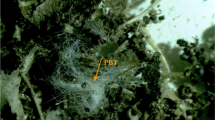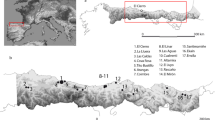Summary
The present paper examines the concentration of mercury in 48 moult-feathers (primaries and secondaries) of the Sparrowhawk from the Erzgebirge region (province of Saxony, Germany). The feathers were collected from 37 females between 1980 and 1998. Five feather-samples of museum-preparations, collected in the area of the federal state of Sachsen before 1930, serve to provide a comparison with times with a low Hg use. All samples were analysed by the Hamburg proton micro-probe. The mercury contents of the moultfeathers from the same bird showed relatively great differences (n=3 ♀♀). Only one female showed a clear reduction of the Hg concentration with the progressive moult of the primaries. The feather-samples, collected before 1930, contained 2.7 ppm mercury (n=5). The concentration increased in the eighties up to 22.6 ppm (n=25) and decreased to 4.0 ppm in 1997/98. There was a reduction of the amount of mercury entering the environment as a result of human activities after 1990. Regional deviations of contamination were characteristic between the area of the city Chemnitz and the highly contaminated surroundings (1980–1990). The highest mercury concentration was established in the moult-feathers from the region of Niederwiesa-Flöha-Falkenau (county Freiberg, 1990).
Zusammenfassung
In der vorliegenden Arbeit wird der Quecksilbergehalt von 48 Mauserfedern (Hand- und Armschwingen) des Sperbers aus dem Erzgebirge (Freistaat Sachsen, BRD) untersucht. Die Federn stammen von 37 Weibchen und wurden zwischen 1980 und 1998 gesammelt. Zum Vergleich dienen fünf Federproben von Museumspräparaten, die vor 1930 auf dem Gebiet des Freistaates Sachsen gesammelt wurden. Die Federproben wurden mit der Hamburger Protonenmikrosonde analysiert. Die Quecksilbergehalte der Mauserfedern des selben Vogels können relativ große Unterschiede aufweisen (n=3 ♀♀). Eine deutliche Reduktion der Hg-Konzentration mit fortschreitender Handschwingenmauser zeigte nur ein Weibchen. Als Vergleichswert für eine Hg-Grundbelastung vor 1930 wurden 2,7 ppm Hg (n=5) ermittelt. Die in den 1980er Jahren stark angestiegenen Konzentrationswerte (xG=22,6 ppm, n=25) fielen 1997/98 auf 4,0 ppm Hg (n=10) ab, was auf eine Verringerung des anthropogenen Quecksilbereintrages in die Umwelt nach 1990 schließen lässt. Regionale Kontaminationsunterschiede zeichneten sich zwischen dem Gebiet der Großstadt Chemnitz und dem höher belasteten Umland ab (1980–1990). Die höchsten Quecksilbergehalte wurden in Sperberfedern aus dem Bereich Niederwiesa-Flöha-Falkennau festgestellt (Landkreis Freiberg).
Similar content being viewed by others
Literatur
Becker, P. H. (1992): Egg mercury levels decline with the laying sequence in Charadriiformes. Bull. Environ. Contam. Toxicol. 48: 762–767.
Becker, P. H., Conrad, B. & Sperveslage, H. (1989): Chlororganische Verbindungen und Schwermetalle in weiblichen Silbermöwen (Larus argentatus) und ihren Eiern mit bekannter Legefolge. Vogelwarte 35: 1–10.
Becker, P. H., Ternes, W. & Rüssel, H. A. (1985): Schadstoffe in Gelegen von Brutvögeln der deutschen Nordseeküste. II. Quecksilber. J. Ornithol. 126: 253–262.
Becker, P. H., Thyen, S., Mickstein, S., Sommer, U. & Schmieder, K. R. (1998): Monitoring pollutants in coastal bird eggs in the Wadden Sea. Final report of the pilot study 1996–1997. Wadden Sea Ecosystem No. 8. Common Wadden Sea Secretariat, Wilhelmshaven: 55–101.
Bednarek, W., Hausdorf, W., Jörissen, U., Schulte, E. & Wegener, H. (1975): Über die Auswirkung der chemischen Umweltbelastung auf Greifvögel in zwei Probeflächen Westfalens. J. Ornithol. 116: 181–194.
Berg, W., Johnels, A., Sjöstrand, B. & Westermark, T. (1966): Mercury content in feathers of Swedish birds from the past 100 years. Oikos 17: 71–83.
Borg, K., Wanntrop, H., Erne, K. & Hanko, E. (1966): Experimental secondary methyl mercury pesticides in the environment and their effects on wildlife. J. appl. Ecol. 3: 171–172.
Borg, K., Wanntrop, H., Erne, K. & Hanko, E. (1969): Alkyl mercury poisoning in terrestical Swedish wildlife. Viltrevy 6: 301–379.
Bühler, U. & Norheim, G. (1981): The mercury content in feathers of the SparrowhawkAccipiter nisus in Norwey. Fauna Nor., Ser. C, Cinclus 5: 43–46.
Fimreite, N. (1970): Mercury uses in Canada and their possible hazards as sources of mercury contamination. Environ. Pollut. 1: 119–131.
Furness, R. W., Muirhead, S. J. & Woodburn, M. (1986): Using bird feathers to measure mercury in the environment: Relationships between mercury content and moult. Mar. Pollut. Bull. 17: 27–30.
Gedeon, K. & Meyer, H. (1986): Studien zur Nistökologie und Reproduktion des Sperbers,Accipiter nisus, im Erzgebirge. Hercynia N. F. 23: 397–402.
Gedeon, K. & Oehme, G. (1993): Die Schalendicke von Sperbereiern aus dem Erzgebirge und dessen Vorland in den Jahren 1979–1990. Beitr. Vogelkd. 39: 137–145.
Glutz v. Blotzheim, U. N., Bauer, M. K. & Bezzel, E. (1989): Handbuch der Vögel Mitteleuropas. Bd. 4 Falconiformes, 2. Aufl. Wiesbaden.
Hulpke, H., Koch, H. A. & Wagner, R. (1995): Römpp Lexikon Umwelt. Stuttgart, New York.
Jensen, S., Johnels, A. G. & Olsson, M. (1972): The avifauna of Sweden as indicators of environmental contamination with mercury and chlorinated hydrocarbons. Proc. Int. Ornithol. Congr. Leiden: 455–465.
Johnels, A. G., Tyler, G. & Westermark, T. (1979): History of mercury levels in Swedish fauna. Ambio 8: 160–168.
Koeman, J. H., Vink, J. A. J. & de Goejj, J. J. M. (1969): Causes of mortality in birds of prey and owls in the Nederlands in the winter of 1968–1969. Ardea 57: 67–76.
Kohsiek, H. (1991): Zum Stand der Zulassung für Pflanzenschutzmittel in den fünf Ländern der ehemaligen DDR. Nachr.bl. Dtsch. Pflanzenschutzd. 43: 62–63.
Lewis, S. A., Becker, P. H. & Furness, R. W. (1993): Mercury levels in eggs, tissues, and feathers of Herring GullsLarus argentatus from the German Wadden Sea coast. Environ. Pollut. 80: 293–299.
Lindberg, P. & Odsjö, T. (1983): Mercury levels in feathers of Peregrine FalconFalco peregrinus compared with total mercury content in some of its prey species in Sweden. Environ. Pollut. (Series B) 5: 297–318.
Newton, I. (1979): Population ecology of raptors. Berkhamsted.
Newton, I., Wyllie, I. & Asher, A. (1993): Long-term trends in organochlorine and mercury residues in some predatory birds in Britain. Environ. Pollut. 79: 143–151.
Niecke, M. (1991): PIXE — Pikogramm-Protonenmikrosonde. Labor 2000: 94–102.
Niecke, M., Ambor, S., Kühnast, O. & Ellenberg, H. (1990): Vogelfedern als Biomonitoren für die atmosphärische Schwermetallbelastung — Untersuchungen mit der Protonenmikrosonde (Teil I und II). UWSF — Z. Umw.chem. Ökotox. 2: 71–75, 188–192.
Niecke, M. & Krüger, A. (1997): Schwermetalle in Vogelfedern — Systematische Untersuchung von externer Deposition und Einlagerung in die Feder. Beitr. Gefied.kd. Morphol. Vögel, Heft 4: 1–20.
Niecke, M., Krüger, A., Hauff, P., Ellenberg, H., Labes, R. & Niecke, S. (1998): Analyse von Quecksilber in Seeadlerfedern aus Mecklenburg-Vorpommern mit Hilfe der Hamburger Protonenmikrosonde. UWSF — Z. Umw.chem. Ökotox. 10: 3–14.
Oehme, G. (1981): Zur Quecksilberrückstandsbelastung tot aufgefundener Seeadler,Haliaeetus albicilla, in den Jahren 1967–1978. Hercynia N. F. 18: 353–364.
Stresemann, E. & Stresemann, V. (1966): Die Mauser der Vögel. J. Ornithol. 107. Sonderheft.
Thompson, D. R., Becker, P. H. & Furness, R. W. (1993): Long-term changes in mercury concentrations in Herring GullsLarus argentatus and Common TernsSterna hirundo from the German North Sea coast. J. Appl. Ecol. 30: 316–320.
Thompson, D. R. & Furness, R. W. (1989): Comparison of the levels of total and organic mercury in seabird feathers. Mar. Pollut. Bull. 20: 577–579.
Weber, M., Gedeon, K. & Meyer, H. (1997): Zur Schadstoffbelastung des Sperbers (Accipiter nisus) im Erzgebirge. Mitt. Ver. Sächs. Ornithol. 7: 95–104.
Weber, M., Fieber, W. & Stubbe, M. (1998): Persistente chlororganische Verbindungen, Quecksilber und radioaktive Nuklide in Eiern von Rotmilanen (Milvus milvus) aus Sachsen-Anhalt. J. Ornithol. 139: 141–147.
Westermark, T., Odsjö, T. & Johnels, A. G. (1975): Mercury content of bird feathers before and after Swedish ban on alkyl mercury in agriculture. Ambio 4: 87–92.
Author information
Authors and Affiliations
Rights and permissions
About this article
Cite this article
Weber, M., Niecke, M., Gedeon, K. et al. Quecksilber in Federn des Sperbers(Accipiter nisus) aus dem Erzgebirge. J Ornithol 142, 313–320 (2001). https://doi.org/10.1007/BF01651370
Accepted:
Published:
Issue Date:
DOI: https://doi.org/10.1007/BF01651370




